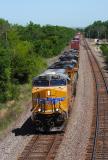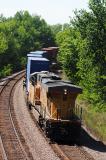
| Home | Open Account | Help | 296 users online |
|
Member Login
Discussion
Media SharingHostingLibrarySite Info |
Western Railroad Discussion > Have a GSR day!Date: 07/28/14 11:15 Have a GSR day! Author: santafe199 I’ve been doing some general “housecleaning” in my files and ran across this story & idea I never followed up on a couple of years ago. Love it or hate it, everybody in the universe knows that little yellow smiley face that (now) sardonically implores you to ‘have a nice day’. The phrase itself has probably been (over) used only about a half-billion times since its inception. The yellow logo and its use has been anywhere on the scale from well-meaning, to sarcastic, to down-right scathing. And I’m sure there have been a few X-rated versions batted about…
Two years ago my title for this thread was only a ‘working title’, but it sorta stuck. Especially after I got to thinking about the initials: GSR. For the few of you still un-initiated, GSR stands for the old Rock Island’s ‘Golden State Route’, which is the current UP mainline between Topeka, KS & Tucumcari, NM. For those of us who shoot this mainline regularly GSR rolls off the tongue much more economically than the fully pronounced version. Back to the title: The initials GSR kinda gave me an idea for another, more satirical take on that ubiquitous yellow smiley face. I do have Photoshop, but I have nowhere near the skill with it to produce what I have in mind. So perhaps someone out there in TO land (with nothing better to do) might be able to pinch-hit for me: Take the GSR initials and fashion them into a sort of smiling logo, and maybe we can put a new railfan twist on a hugely over-used phrase. Here are the photos from that GSR day from 2 years ago. I was out shooting with my frequent partner Milw E70. Just routine stuff from the land of OZ. 1. & 2. UP 7352 crossing the main drag [Missouri St & KS hwy 99] in Alma, KS. Edited 1 time(s). Last edit at 07/28/14 11:24 by santafe199.   Date: 07/28/14 11:16 Re: Have a GSR day! Author: santafe199 3. & 4. We were mobile enough to catch the 7352 again at Alta Vista, KS off of Lil Wes’ overpass.
5. UP 5528 is the DP mated to the 7352 at Alta Vista.    Date: 07/28/14 11:18 Re: Have a GSR day! Author: santafe199 6. We doubled back to just west of the ghost town of Volland, KS. UP 7503 is rolling westbound with a stacker.
7. Reversing directions again we catch the 7503 again just east of Dwight, KS. 8. UP 5780 is the DP mated up with the 7503, also just east of Dwight.    Date: 07/28/14 11:21 Re: Have a GSR day! Author: santafe199 9. We double back east yet again to catch 7453 in a more scenic shot, be the train surprises at the east side of Alta Vista. [This is the Logan St~Tri-County Rd overpass].
10. & 11. Railfan mobility allows us to run back to Dwight for more shots of UP 7453 crossing over Dwight’s main drag [7th St & KS hwy 57]. Next, we had to thumb a ride to a nearby gas station... ;^) (11 photos taken April 25, 2012) Have a nice :^)! Lance Garrels santafe199 Edited 1 time(s). Last edit at 07/28/14 11:26 by santafe199.    Date: 07/28/14 12:30 Re: Have a GSR day! Author: coach How refreshing to see those modern "Rock Island style" circle tri-lights that SP installed. One thing I've always wondered is why the red light is on the bottom? Why orient the signal face so the red light is at top?
Date: 07/28/14 12:56 Re: Have a GSR day! Author: santafe199 coach Wrote:
> ...I've always wondered is why the red light is on the bottom? Railroad traditions die hard, if at all. I suspect the red signal being at the bottom is a natural carry over from the semaphore blade days. When semaphore blade was in the 'stop' position (as in a barrier put down across your path) it was referred to as "knocked down". That is, a train passing the straight-up semaphore blade (in clear-proceed position) would cause it to drop down into the stop position when the track circuit was shunted, or occupied. Thus, a train passing a clear signal would "knock it down". That slang is still used today just about everywhere with color-light signals. From time immemorial when wanted you to stop someone's forward movement you put a barrier "down" across his path. When you want him to pass, you pull the barrier up. So generally the word 'down' is psychologically more restrictive than the word up. The full explanation is undoubtedly a lot more complicated, and I'm sure there are exceptions to what I just described... BTW: These shots are over 2 years old. The tri-lights at Alta Vista are long-gone... Lance Edited 1 time(s). Last edit at 07/28/14 12:57 by santafe199. Date: 07/28/14 14:22 Re: Have a GSR day! Author: ns1000 Nice pics!!! Pic 3 is one of my favorites.
Date: 07/28/14 15:35 Re: Have a GSR day! Author: twjurgens santafe199 Wrote:
------------------------------------------------------- > coach Wrote: > > ...I've always wondered is why the red light is > on the bottom? > > Railroad traditions die hard, if at all. I suspect > the red signal being at the bottom is a natural > carry over from the semaphore blade days. When > semaphore blade was in the 'stop' position (as in > a barrier put down across your path) it was > referred to as "knocked down". That is, a train > passing the straight-up semaphore blade (in > clear-proceed position) would cause it to drop > down into the stop position when the track circuit > was shunted, or occupied. Thus, a train passing a > clear signal would "knock it down". That slang is > still used today just about everywhere with > color-light signals. From time immemorial when > wanted you to stop someone's forward movement you > put a barrier "down" across his path. When you > want him to pass, you pull the barrier up. So > generally the word 'down' is psychologically more > restrictive than the word up. The full explanation > is undoubtedly a lot more complicated, and I'm > sure there are exceptions to what I just > described... > > BTW: These shots are over 2 years old. The > tri-lights at Alta Vista are long-gone... > > Lance I saw an article several years ago that indicated that light positions may have been related to signals in the early days of railroads. Signal masts had a ball on them and the ball was raised or lowered to indicate whether a train should stop or proceed. A "high ball" indicated that a train could proceed. Most of the signals I see around here follow that practice, green on top and red on the bottom with yellow in the middle. |